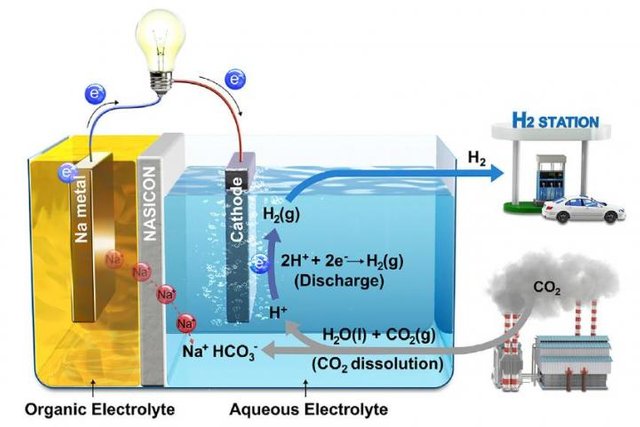Prof Kim and the team realised that this could be used to induce an electrochemical reaction. The creation of an acidic solution increases the number of protons in the water, each of which can attract an electron, and this implies that a battery system can be created.
“Carbon capture, utilisation, and sequestration (CCUS) technologies have recently received a great deal of attention for providing a pathway in dealing with global climate change,” says Prof Kim. “The key to that technology is the easy conversion of chemically stable CO2 molecules to other materials.” He adds, “Our new system has solved this problem with CO2 dissolution mechanism.”
The fuel cell system consists of a sodium metal anode submerged in an organic electrolyte, a separation membrane consisting of a sodium super ionic conductor (NASICON) ceramic, and a catalytic cathode (the researchers used platinum) in an aqueous electrolyte, which could be distilled water, seawater or a sodium hydroxide solution. The researchers explain in iScience how injecting carbon monoxide into the water triggers a reaction, with gaseous hydrogen liberated at the cathode – which can then be used in conventional fuel cells – and current flowing in an external circuit. Sodium ions are liberated from the anode, pass through the membrane and recombine with the hydrogen carbonate ions formed by the dissolution of carbon dioxide. In the system’s current form, the conversion efficiency of CO2 is 50 per cent
The “hybrid Na-CO2 cell” continues to produce electricity and hydrogen and does not regenerate carbon dioxide during charging, the team says. The system has been tested over more than a thousand hours with no damage to the electrodes. “This hybrid Na- CO2cell, which adopts efficient CCUS technologies, not only utilises CO2 as the resource for generating electrical energy but also produces the clean energy source, hydrogen,” said Jeongwon Kim, electrical engineer at Unist and co-first author for the research.
“This research will lead to more derived research and will be able to produce H2 and electricity more effectively when electrolytes, separator, system design, and electrocatalysts are improved.”
Source
Copying/Pasting full or partial texts without adding anything original is frowned upon by the community. Repeated copy/paste posts could be considered spam. Spam is discouraged by the community, and may result in action from the cheetah bot.
More information and tips on sharing content.
If you believe this comment is in error, please contact us in #disputes on Discord
Downvoting a post can decrease pending rewards and make it less visible. Common reasons:
Submit
Hi! I am a robot. I just upvoted you! I found similar content that readers might be interested in:
https://www.theengineer.co.uk/fuel-cell-based-system-co2/
Downvoting a post can decrease pending rewards and make it less visible. Common reasons:
Submit